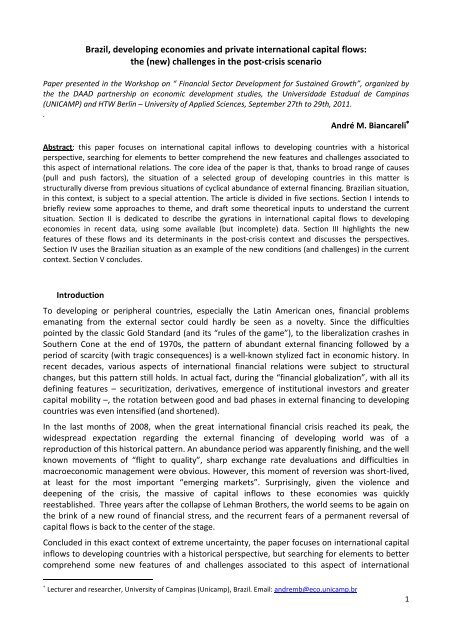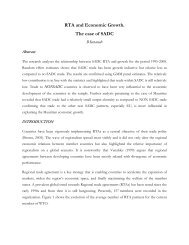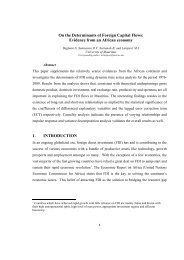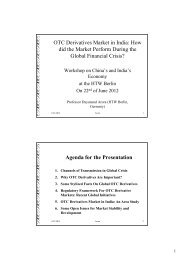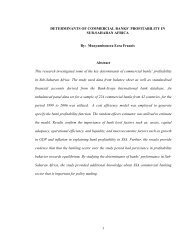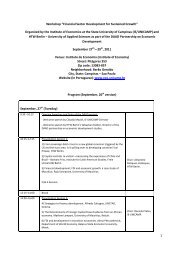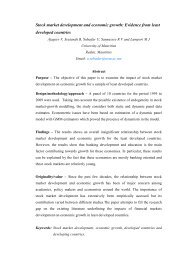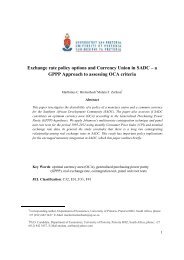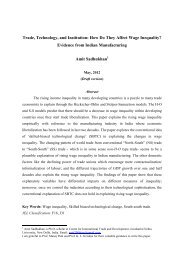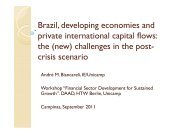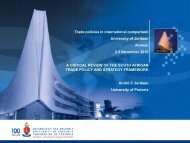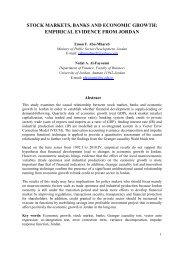Brazil, developing economies and private international capital flows ...
Brazil, developing economies and private international capital flows ...
Brazil, developing economies and private international capital flows ...
You also want an ePaper? Increase the reach of your titles
YUMPU automatically turns print PDFs into web optimized ePapers that Google loves.
<strong>Brazil</strong>, <strong>developing</strong> <strong>economies</strong> <strong>and</strong> <strong>private</strong> <strong>international</strong> <strong>capital</strong> <strong>flows</strong>:<br />
the (new) challenges in the post-crisis scenario<br />
Paper presented in the Workshop on “ Financial Sector Development for Sustained Growth”, organized by<br />
the the DAAD partnership on economic development studies, the Universidade Estadual de Campinas<br />
(UNICAMP) <strong>and</strong> HTW Berlin – University of Applied Sciences, September 27th to 29th, 2011.<br />
.<br />
André M. Biancareli ∗<br />
Abstract: this paper focuses on <strong>international</strong> <strong>capital</strong> in<strong>flows</strong> to <strong>developing</strong> countries with a historical<br />
perspective, searching for elements to better comprehend the new features <strong>and</strong> challenges associated to<br />
this aspect of <strong>international</strong> relations. The core idea of the paper is that, thanks to broad range of causes<br />
(pull <strong>and</strong> push factors), the situation of a selected group of <strong>developing</strong> countries in this matter is<br />
structurally diverse from previous situations of cyclical abundance of external financing. <strong>Brazil</strong>ian situation,<br />
in this context, is subject to a special attention. The article is divided in five sections. Section I intends to<br />
briefly review some approaches to theme, <strong>and</strong> draft some theoretical inputs to underst<strong>and</strong> the current<br />
situation. Section II is dedicated to describe the gyrations in <strong>international</strong> <strong>capital</strong> <strong>flows</strong> to <strong>developing</strong><br />
<strong>economies</strong> in recent data, using some available (but incomplete) data. Section III highlights the new<br />
features of these <strong>flows</strong> <strong>and</strong> its determinants in the post-crisis context <strong>and</strong> discusses the perspectives.<br />
Section IV uses the <strong>Brazil</strong>ian situation as an example of the new conditions (<strong>and</strong> challenges) in the current<br />
context. Section V concludes.<br />
Introduction<br />
To <strong>developing</strong> or peripheral countries, especially the Latin American ones, financial problems<br />
emanating from the external sector could hardly be seen as a novelty. Since the difficulties<br />
pointed by the classic Gold St<strong>and</strong>ard (<strong>and</strong> its “rules of the game”), to the liberalization crashes in<br />
Southern Cone at the end of 1970s, the pattern of abundant external financing followed by a<br />
period of scarcity (with tragic consequences) is a well-known stylized fact in economic history. In<br />
recent decades, various aspects of <strong>international</strong> financial relations were subject to structural<br />
changes, but this pattern still holds. In actual fact, during the “financial globalization”, with all its<br />
defining features – securitization, derivatives, emergence of institutional investors <strong>and</strong> greater<br />
<strong>capital</strong> mobility –, the rotation between good <strong>and</strong> bad phases in external financing to <strong>developing</strong><br />
countries was even intensified (<strong>and</strong> shortened).<br />
In the last months of 2008, when the great <strong>international</strong> financial crisis reached its peak, the<br />
widespread expectation regarding the external financing of <strong>developing</strong> world was of a<br />
reproduction of this historical pattern. An abundance period was apparently finishing, <strong>and</strong> the well<br />
known movements of “flight to quality”, sharp exchange rate devaluations <strong>and</strong> difficulties in<br />
macroeconomic management were obvious. However, this moment of reversion was short-lived,<br />
at least for the most important “emerging markets”. Surprisingly, given the violence <strong>and</strong><br />
deepening of the crisis, the massive of <strong>capital</strong> in<strong>flows</strong> to these <strong>economies</strong> was quickly<br />
reestablished. Three years after the collapse of Lehman Brothers, the world seems to be again on<br />
the brink of a new round of financial stress, <strong>and</strong> the recurrent fears of a permanent reversal of<br />
<strong>capital</strong> <strong>flows</strong> is back to the center of the stage.<br />
Concluded in this exact context of extreme uncertainty, the paper focuses on <strong>international</strong> <strong>capital</strong><br />
in<strong>flows</strong> to <strong>developing</strong> countries with a historical perspective, but searching for elements to better<br />
comprehend some new features of <strong>and</strong> challenges associated to this aspect of <strong>international</strong><br />
∗ Lecturer <strong>and</strong> researcher, University of Campinas (Unicamp), <strong>Brazil</strong>. Email: <strong>and</strong>remb@eco.unicamp.br<br />
1
elations, especially for <strong>Brazil</strong> case. The core idea of the paper is that, thanks to broad range of<br />
causes (pull <strong>and</strong> push factors), the situation of a selected group of <strong>developing</strong> countries in this<br />
matter is structurally diverse from previous situations of cyclical abundance of external financing.<br />
The article is divided in five sections apart this Introduction. Section I intends to briefly review<br />
some approaches to theme, <strong>and</strong> draft some theoretical inputs to underst<strong>and</strong> the current situation.<br />
Section II is dedicated to describe the gyrations in <strong>international</strong> <strong>capital</strong> <strong>flows</strong> to <strong>developing</strong><br />
<strong>economies</strong> in recent data, using some available (but incomplete) data. Section III highlights the<br />
new features of these <strong>flows</strong> <strong>and</strong> its determinants in the post-crisis context <strong>and</strong> discusses the<br />
perspectives. Section IV uses the <strong>Brazil</strong>ian situation as an example of the new conditions (<strong>and</strong><br />
challenges) in the current context. Section V concludes.<br />
I. Theoretical issues<br />
In theoretical ground, the reality of phases, or cycles, in <strong>international</strong> <strong>capital</strong> <strong>flows</strong> to <strong>developing</strong><br />
countries is, first of all, a clear challenge (or “puzzle”) to the idealized view of <strong>international</strong><br />
financial relations that arises from classical orthodox formulations, summarized by Obstfeld <strong>and</strong><br />
Taylor (2004, ch. 1). If one would follow strictly the theoretical benefits of financial opening<br />
(<strong>international</strong> risk-sharing; inter-temporal trade; macroeconomic discipline), that would be a nonquestion:<br />
the <strong>capital</strong> should flow, in a continuous mode, to where it is scarce, to where the<br />
interest rate is higher <strong>and</strong> investment opportunities are better <strong>and</strong>, of course, to where the<br />
macroeconomic policy is "correct".<br />
Driven by the recurrent crises <strong>and</strong> also by the historical evidence that “the <strong>capital</strong> does not flow<br />
from rich to poor countries” (Lucas, 1990), an important trend in the literature dedicated to this<br />
topic is a broad recognition of the oscillations in <strong>private</strong> <strong>capital</strong> <strong>flows</strong> to <strong>developing</strong> countries.<br />
Some of the examples, emanating from economists <strong>and</strong> institutions of the so-called “mainstream<br />
economics”, are noteworthy.<br />
Under the impact of 1990's crises, Calvo <strong>and</strong> Reinhart (2000) identified the occurrence of “sudden<br />
stops” in <strong>capital</strong> <strong>flows</strong> to <strong>developing</strong> countries, mainly after a period of persistent current account<br />
deficits, leading to bankruptcies, human <strong>capital</strong> <strong>and</strong> financial domestic channels destruction, <strong>and</strong><br />
so on. Kaminsky, Reinhart <strong>and</strong> Vegh (2004) proposed that the absorption of <strong>capital</strong> in<strong>flows</strong> by<br />
<strong>developing</strong> countries is "pro-cyclical", as well as are, in general, the monetary <strong>and</strong> fiscal policies<br />
adopted by host countries in times of abundance. More recently, amid the deepening of USoriginated<br />
financial crisis, <strong>and</strong> thinking about its possible impacts on <strong>developing</strong> <strong>economies</strong>'<br />
external financing, Reinhart <strong>and</strong> Reinhart (2008) used the term "<strong>capital</strong> flow bonanzas" to<br />
designate phases of large <strong>capital</strong> in<strong>flows</strong>, identified in a large sample of developed <strong>and</strong> <strong>developing</strong><br />
countries from 1980 to 2006.<br />
As discussed in sections below, the decline in <strong>capital</strong> <strong>flows</strong> during the 2008 crisis was short-lived,<br />
<strong>and</strong> a new wave of them reached <strong>developing</strong> countries since mid-2009. In the wake of this return,<br />
new concepts <strong>and</strong> empirical findings: the periods of large in<strong>flows</strong> to <strong>developing</strong> countries could be<br />
described in terms of “surges”, “episodes” or “waves” (IMF, 2011; Cardarelli et al., 2010; Furceri et<br />
al., 2011).<br />
Along this theoretical evolution, however, few integrated explanations were proposed to link<br />
these systematic quantitative analyses. Furthermore, rarely the empirical findings were followed<br />
by policy recommendations to protect the <strong>economies</strong> from the gyrations in <strong>capital</strong> <strong>flows</strong>. In this<br />
matter, the recent publications of IMF supporting (<strong>and</strong> trying to discipline) the use <strong>capital</strong> controls<br />
(Ostry et al., 2010 <strong>and</strong> 2011; IMF, 2011) are also a sign of change. 1 Even in the heterodox field, the<br />
1 The contrast with other publications about the same topic (like IMF, 2007 <strong>and</strong> World Bank, 2008) is revealing.<br />
2
analyses (e. g. Akyuz, 2011; UNCTAD, 1999 <strong>and</strong> 2006) tend to prioritize the description <strong>and</strong> policy<br />
implications of <strong>capital</strong> <strong>flows</strong> – here with a clear sense of prudence <strong>and</strong> self-protection.<br />
Filling this lack of a consolidated background to deal with the question is not the goal of the<br />
present article. Nevertheless, some inputs from a heterodox literature, mixed with recent<br />
concepts emphasized even inside the mainstream, can here be gathered, in order to better<br />
comprehend the external financial conditions faced by <strong>developing</strong> <strong>economies</strong> <strong>and</strong> the new<br />
settings of this issue.<br />
In such approach, the cyclical nature of <strong>capital</strong> <strong>flows</strong> can be seen as a result of at least two<br />
structural features of contemporary <strong>international</strong> financial relations: its instability <strong>and</strong> its<br />
asymmetries. Both affect adversely the <strong>developing</strong> world.<br />
First of all, contemporary <strong>international</strong> <strong>capital</strong> <strong>flows</strong> are considered to be intrinsically volatile <strong>and</strong><br />
moved by the search for short-term yield. The financial globalization era is understood here not<br />
just as a period of increased financial <strong>flows</strong> <strong>and</strong> external assets/liabilities stocks. More than that, it<br />
is characterized by some important qualitative shifts in financial relations: the emergence of<br />
institutional investors as major sources of funding; the growing importance of “market finance”<br />
(i.e., the predominance of financial relations through the issuing of stocks, bonds <strong>and</strong> other<br />
securities, a trend also called “securitization”) vis-à-vis “bank finance”; the dissemination of<br />
derivatives instruments in these relations; <strong>and</strong> the broad liberalizing reforms that result in a<br />
greater <strong>capital</strong> mobility around the world. 2<br />
Mainly in response to securitization <strong>and</strong> institutionalization of savings, the speculative pattern of<br />
behavior – in a Keynesian sense: the attempt to anticipate the market tendency – was<br />
disseminated throughout the spectrum of economic agents (banks, firms, families). Regarding<br />
<strong>international</strong> financial relations, the wider possibilities of portfolio diversification, ensured by<br />
abolition of <strong>capital</strong> controls, gave rise to large speculative cross border <strong>capital</strong> movements – in the<br />
form of bank <strong>flows</strong>, equity <strong>flows</strong> (directly or through an investment, pension or hedge fund) <strong>and</strong><br />
even FDI <strong>flows</strong> to a lesser extent. The logic is always the same: the search for short-term <strong>capital</strong><br />
gains, at different <strong>economies</strong>. If the contemporary <strong>international</strong> monetary system is taken into<br />
account, the volatile nature of typical <strong>capital</strong> <strong>flows</strong> in the globalization era is reinforced: both the<br />
absence of clear rules <strong>and</strong> the fiduciary basis of US dollar dominance magnify the risks <strong>and</strong><br />
possibilities of sudden expectation reversion. The greater the uncertainty, the more speculative<br />
<strong>and</strong> volatile are financial relations, in an amplified space.<br />
Hence, to this view, the recurrent financial crises are not consequences of ad hoc market failures:<br />
the instability is intrinsic to contemporary <strong>international</strong> financial <strong>and</strong> monetary system.<br />
Furthermore, the assumption is that the situation of the <strong>developing</strong> countries in that unstable<br />
environment is even worse, aggravated by three reinforcing h<strong>and</strong>icaps or asymmetries (Prates,<br />
2005; Ocampo, 2001).<br />
The first asymmetry is a financial one. Developing <strong>economies</strong>, each one <strong>and</strong> as a group, represent<br />
a small share in global portfolios; to the leading <strong>international</strong> investors, those destinations are<br />
always seen as exotics <strong>and</strong> just a fraction of the total is allocated there. As a result, the fragility of<br />
their structural position is revealed: being minor parts of total wealth, the assets allocated in<br />
<strong>developing</strong> countries are the first sell alternative in moments of risk aversion <strong>and</strong>/or huge losses in<br />
other markets. At the same time, a macroeconomic asymmetry exists, i.e., there are fewer<br />
degrees of freedom in macroeconomic management in the <strong>developing</strong> world as compared to the<br />
developed one.<br />
2 All these elements are highlighted by the large <strong>and</strong> varied literature grouped under the general denomination of<br />
“financialization” or “finance-led <strong>capital</strong>ism”. For a recent “primer” of this approaches, see Guttmann (2008).<br />
3
But the third h<strong>and</strong>icap, the monetary asymmetry, is the most important one. The idea is that the<br />
huge qualitative differences among national currencies represent the main factor causing the<br />
financial <strong>and</strong> macroeconomic asymmetries. Because they are not able to perform any of the three<br />
basic functions of money (unit of account; medium of exchange <strong>and</strong>, specially, store of value) in<br />
<strong>international</strong> transactions, almost all <strong>developing</strong> countries’ currencies are considered to be<br />
“provisory” or “unconvertible”. 3 In Keynesian terms, those are not monies which “lulls the<br />
disquietude” of global investors.<br />
To sum up, in a global financial environment which is intrinsically unstable, the inferior position of<br />
some <strong>economies</strong> is worsened by these three disadvantages – the financial, the macroeconomic<br />
<strong>and</strong> (above all) the monetary asymmetries. As a result of these structural characteristics, the<br />
movement of <strong>private</strong> <strong>capital</strong> <strong>flows</strong> to <strong>developing</strong> countries, issuers of currencies that are not<br />
<strong>international</strong>ly liquid, is always a consequence of a reduction in liquidity preference in the<br />
<strong>international</strong> level (or a decrease in risk aversion).<br />
As in a stylized Minskyan financial cycle, a confidence phase – i.e., an optimistic period, when the<br />
expectation on future yields support financial transactions involving more <strong>and</strong> more risky agents –<br />
also can be identified here, based on some common beliefs about those host <strong>economies</strong>, their<br />
risks <strong>and</strong> future opportunities. In the original formulation, the increasing financial fragility turns<br />
into financial crisis in the aftermath of an expectation shock, a drastic reversion of optimism about<br />
future <strong>and</strong> a sudden increase in liquidity preference (Minsky, 1982). Regarding <strong>international</strong> <strong>flows</strong>,<br />
any event that induces a reevaluation of the risk/return combination of assets denominated in<br />
inferior currencies is able to trigger a “flight to quality” – an increasing in risk aversion or in<br />
liquidity preference in this <strong>international</strong> sense.<br />
At this point, some important issues arise. What kind of event can play this role of expectation<br />
reversal? Or, in more general terms, what drives the rotation from an optimistic to a pessimistic<br />
period in <strong>international</strong> <strong>capital</strong> <strong>flows</strong> to <strong>developing</strong> <strong>economies</strong>? Besides the psychological aspects,<br />
are there economic processes that lead these changes in expectation, liquidity preference <strong>and</strong> risk<br />
aversion? Searching for answers to these questions, the relative importance of external <strong>and</strong><br />
domestic factors – also known as “push <strong>and</strong> pull factors” – has been the subject of a long debate,<br />
both in theoretical or empirical grounds. 4<br />
The heterodox view tends to put emphasis more on the first set of influences than on the<br />
“fundamentals” of receiving <strong>economies</strong> (like “sound” macroeconomic indicators <strong>and</strong> policies,<br />
perspectives, rules etc.). In normal times, variables like global <strong>and</strong> central <strong>economies</strong>’ growth rates<br />
<strong>and</strong> the interest rates of central currencies (firstly of the US dollar), are more important.<br />
However, an additional aspect of this general picture needs to be clarified. Both in the optimistic<br />
<strong>and</strong> in the pessimistic moments, the convention shifts can give rise to a more long term movement<br />
– the “high” <strong>and</strong> “low tide” phases in external financial environment – or can be just a brief “up”<br />
or “down” moment, unable to offset the broad <strong>and</strong> longer trend. These ephemeral occurrences<br />
can be associated with the “sudden stops” identified by Calvo <strong>and</strong> Reinhart (2000), but the point<br />
to emphasize here is that an abrupt reversion of optimism not necessarily turns into a long phase<br />
of external finance shortage.<br />
In fact, the length of a period of scarcity (<strong>and</strong> the same is valid for one of abundance) seems to<br />
depend on a complex interaction between domestic <strong>and</strong> external factors governing <strong>capital</strong> <strong>flows</strong>.<br />
3<br />
The monetary hierarchy is also a topic studied by a large range of approaches, even among orthodox authors.<br />
Besides the classic works of Cohen (1977 <strong>and</strong> 1998), see also Carneiro (2008) <strong>and</strong> McKinnon (2002).<br />
4<br />
Examples vary from the discussion about the return of <strong>flows</strong> to Latin America during the first half of 1990s (Calvo et<br />
al., 1993; El-Erian, 1992) to very recent assessments of the trends after the 2008 financial crisis (Fratzcher, 2011).<br />
4
Particularly, the probability of a “flight to quality” initiates a more lasting phase of difficulties is<br />
commonly associated with the level of fragility caused by the in<strong>flows</strong> in the profusion period. The<br />
main sources of this fragility are well described in the literature.<br />
Akyuz (2011), for example, identifies some channels of external vulnerability of <strong>developing</strong><br />
<strong>economies</strong> to a reversal of <strong>capital</strong> <strong>flows</strong> cycle: the creation of credit <strong>and</strong> asset bubbles in booming<br />
periods; the cycles of primary commodities prices usually associated with the financial cycle<br />
(which points to a risk of deterioration also in the current account when the “bust” time comes);<br />
the uncontrolled expansion of domestic credit with external funding (especially when directed to<br />
consumption <strong>and</strong> production of non-tradable goods); <strong>and</strong>, above all, the accumulation of large<br />
external liabilities denominated in foreign currencies in response to exchange rate appreciation<br />
<strong>and</strong> current account deficits.<br />
These last two phenomena have also been emphasized in recent years by some important<br />
mainstream authors, since the identification of “twin crisis” in emerging <strong>economies</strong> during the<br />
1990s – i.e., an exchange rate crisis that, thanks to the foreign-currency denominated liabilities<br />
accumulated in public sectors, families, companies <strong>and</strong> banks balances, turns into a financial <strong>and</strong><br />
economic crisis (if not a fiscal one, too). 5 In fact, the so-called “balance-sheet approach” to deal<br />
with <strong>developing</strong> <strong>economies</strong> external vulnerabilities – of which the best developments are the<br />
concepts of “currency mismatches” (Goldstein <strong>and</strong> Turner, 2004) <strong>and</strong> “original sin” (Eingengreen<br />
<strong>and</strong> Haussman, orgs., 2005) – is nowadays clearly considered “conventional wisdom” in these<br />
matters.<br />
In summary, the theoretical considerations above led to the conclusion that the assessment of<br />
<strong>capital</strong> in<strong>flows</strong> to <strong>developing</strong> countries, especially the comprehension of its cycles, has to take into<br />
account two groups of determinants. On one h<strong>and</strong>, these oscillations are impossible to be<br />
understood without the consideration of the structural characteristics of contemporary<br />
<strong>international</strong> financial relations – mainly its instability <strong>and</strong> asymmetries. The availability of external<br />
financing, in short, is far beyond the control of <strong>developing</strong> countries. On the other h<strong>and</strong>, some<br />
domestic factors – mainly the accumulation of stocks of external liabilities <strong>and</strong> its currency<br />
denomination during an abundance period – also play an important role in this picture. If these<br />
pull factors are not able to avoid a “sudden stop”, they can influence the length of the subsequent<br />
scarcity period.<br />
II. The “long” evidence: two big cycles<br />
Having painted the broad picture in theoretical terms, the next task is describing the cycles. In<br />
chronological terms, the starting point chosen here is the beginning of 1990’s, because of data<br />
availability <strong>and</strong> also for an analytical reason. All the process described above as being the defining<br />
features of financial globalization era – securitization, emergence of institutional investors etc. –<br />
are typical of 1980’s, but just in central <strong>economies</strong>: to <strong>developing</strong> <strong>economies</strong>, that decade was<br />
marked by the complete absence of <strong>private</strong> external finance, which returns just after 1990. In<br />
other words, before this point, there is no financial globalization to <strong>developing</strong> world, neither in<br />
quantitative nor in qualitative terms. This choice, of course, doesn’t mean that the previous cycle<br />
5<br />
The original paper of Kaminsky <strong>and</strong> Reinhart (1999) started a sequence that, passing through the identification of the<br />
“fear of floating” (Calvo <strong>and</strong> Reinhart, 2002) <strong>and</strong> reached an apex with the monumental historical investigation of<br />
Reinhart <strong>and</strong> Rogoff (2009).<br />
5
(the external indebtedness process in 1960’s <strong>and</strong> 1970’s, which will result in 1980’s debt crisis) is<br />
less important. 6<br />
The second methodological option is related to data sources. Theoretically, there are at least two<br />
possibilities of measuring <strong>capital</strong> <strong>flows</strong>: getting the numbers from balance of payments of<br />
receiving countries; or from the creditors’ side (banks, institutional investors, transnational<br />
companies etc.). This second option is only available in partial dimensions – like the UNCTAD’s<br />
annual accounting of FDI announcements in its World Investment Report, or the EPFR weekly<br />
assessment of the movements in portfolio funds dedicated to emerging markets 7 –, making<br />
difficult to paint an overall picture. Turning to the receiving economy side, a case-by-case data<br />
compiling would turn the research impracticable – so, the alternative is to resort to multilateral<br />
institutions dedicated to this task. The first c<strong>and</strong>idate is the International Monetary Fund <strong>and</strong>,<br />
specifically, the International Financial Statistics database. The problem here is that, even in<br />
annual basis, the information regarding <strong>developing</strong> countries available to the general public is<br />
always full of missing data <strong>and</strong> not updated. For this reason, as a complement to this traditional<br />
source, the option was to use the numbers of the Institute of International Finance (IIF), which<br />
also does the accounting for in<strong>flows</strong> to "emerging markets" <strong>and</strong> presents the update data plus<br />
forecasts for subsequent years. 8<br />
Thirdly, it is necessary to clarify which countries are examined. Given the structural differences<br />
inside the large group of “non-industrialized” nations <strong>and</strong> the fact that, to the poorest ones the<br />
<strong>capital</strong> in<strong>flows</strong> are mainly official, the focus is on a selected group of <strong>developing</strong> <strong>economies</strong> that<br />
can be considered a large sample of “emerging markets”: 30 countries from the four <strong>developing</strong><br />
regions. 9 Finally, in terms of the indicators used, the choice is to evaluate the size of in<strong>flows</strong> (i.e.,<br />
acquisition/sells of assets by non-residents, equivalent to variations in domestic economy external<br />
liabilities) always as a share of GDP. The absolute numbers are important, but since the idea is to<br />
compare the evolution through a relatively long period, <strong>and</strong> for simplicity reasons, the relative<br />
measure fits better.<br />
Subject to all this qualifications, the evidence of <strong>capital</strong> in<strong>flows</strong> to <strong>developing</strong> <strong>economies</strong> since<br />
1990 shows long waves, as depicted in Fig. 1 (that used the IMF-IFS based measure complemented<br />
by the IIF-based). The curves described by both measure are quite similar (despite the diverse<br />
periods covered), <strong>and</strong> the slight differences can be attributed to rounding, small changes in<br />
coverage along the time (in IIF sample) <strong>and</strong> some missing numbers in IFS database. For 2010 on,<br />
just the IIF provides forecasts. 10<br />
6<br />
In fact, that cycle was dominated largely by bank loans, a type of flow that shares importance with FDI, equity <strong>and</strong><br />
other securities during the subsequent decades. To more long term assessments, including the 1970’s, see the already<br />
quoted Akyuz (2011) <strong>and</strong> UNCTAD (2006, ch. IV).<br />
7<br />
EPFR (Emerging Portfolio Fund Research) is a <strong>private</strong> company that tracks the global flow of equity <strong>and</strong> bond funds<br />
by country, sector <strong>and</strong> cross border allocations culled from a universe of 15,000 <strong>international</strong> <strong>and</strong> U.S. funds. Its high<br />
frequency information is more suited to guide <strong>private</strong> investors’ decisions, but has been increasingly used also for<br />
analytical purposes, like in IMF (2011) <strong>and</strong> Fratzcher (2011). The data, subject to an expensive subscription, can be<br />
found in http://www.epfr.com.<br />
8<br />
The IIF (an association of more than 400 financial institutions), publishes three times per year a report called Capital<br />
Flows to Emerging Market Economies, accompanied by an aggregated database. See http://www.iif.com/.<br />
9<br />
The list, almost the same used by IIF in its calculations, is made up of <strong>economies</strong> from Emerging Europe (Bulgaria,<br />
Czech Republic, Hungary, Pol<strong>and</strong>, Romania, Russia, Turkey <strong>and</strong> Ukraine); Latin America (Argentina, <strong>Brazil</strong>, Chile,<br />
Colombia, Ecuador, Mexico, Peru <strong>and</strong> Venezuela); Emerging Asia (China, India, Indonesia, Malaysia, Philippines, South<br />
Korea <strong>and</strong> Thail<strong>and</strong>); Africa/Middle East (Egypt, Lebanon, Morocco, Nigeria, South Africa, Saudi Arabia <strong>and</strong> UAE).<br />
10<br />
The World Economic Outlook, one of the flagship reports of IMF, also provides a database with forecasts to <strong>capital</strong><br />
<strong>flows</strong>. But these predictions are not comparable with those of IMF, thanks to a different concept (there, the net <strong>flows</strong><br />
– including residents – are calculated) <strong>and</strong> a much larger sample of <strong>developing</strong> countries covered.<br />
6
In terms of the general trend, if a cycle is taken as an ascendant phase followed by a descendent<br />
one, two cycles are evident: one starting in the first years of 1990s <strong>and</strong> other in the beginning of<br />
2000's. Moreover, it's easy to identify the reversion, the moment when the "high tide" of the first<br />
half of 1990s turned into a lasting "low tide" that, despite some brief recovery in 1999 <strong>and</strong> 2000,<br />
reaches its lowest level in 2002. Other noteworthy facts are the approximate same duration of the<br />
two ascendant phases (five to six years) <strong>and</strong> the much higher values reached in 2007 when<br />
compared to the previous peak (1996).<br />
Observing the figure, the historical record <strong>and</strong> the predictions available in mid-2011 suggest that<br />
the <strong>developing</strong> world entered in 2008 in a more lasting phase of low levels of <strong>capital</strong> in<strong>flows</strong>,<br />
similar to the 1997-2002 interval. Following this reasoning, if the length of the new low tide<br />
repeats the previous one, those <strong>economies</strong> should be prepared for a continuous decrease in<br />
external financing until 2013.<br />
Fig. 1. Capital in<strong>flows</strong> to emerging market <strong>economies</strong>, total, GDP share, 1990-2012.<br />
Source: Own calculations based on data from IMF <strong>and</strong> IIF.<br />
e: preliminary estimation (IIF, june 2011)<br />
f: forecast (IIF, june 2011)<br />
Assessing the evidence by components, both charts of Figure 2 describe a higher importance (<strong>and</strong><br />
stability) of FDI <strong>flows</strong>, while bank debt <strong>and</strong> the two modalities of portfolio <strong>flows</strong> (debt <strong>and</strong> equity)<br />
present a more cyclical behavior, with bank <strong>flows</strong> leading the broad cycle in the critical moments<br />
(1998; 2002; 2008) as well as in the peak of the long trajectory (1997). Having contributed<br />
decisively to the beginning of the first high tide, the portfolio <strong>flows</strong> – by definition the most<br />
volatile ones – show a fast contraction in 2008, but also a rapid return in 2009. The numbers for<br />
2010 <strong>and</strong> 2011, according to IIF, are based much more on the behavior of these investments, since<br />
the prediction for FDI was of a constant decline.<br />
However, such measures do not seem to be a good way to capture the more recent contours of<br />
this aspect of <strong>international</strong> financial relations. There are different signs indicating that the scenario<br />
of a new low tide phase suggested by these figures did not materialize.<br />
7
Fig. 2. Capital in<strong>flows</strong> to emerging market <strong>economies</strong>, major components, GDP share, 1990-2012. IMF-IFS<br />
based measure (left) <strong>and</strong> IIF based measure (right)<br />
Source: Own calculations based on data from IMF <strong>and</strong> IIF.<br />
e: preliminary estimation (IIF, june 2011)<br />
f: forecast (IIF, june 2011)<br />
Both the preliminary account for 2010 <strong>and</strong> predictions to 2011, from IIF, are underestimating the<br />
very fast recovery of in<strong>flows</strong> already captured in other indicators. As an example, in a recent<br />
publication by IMF (2011, Fig. 2, p. 9), quarterly <strong>and</strong> more updated data, related to a smaller<br />
sample of emerging <strong>economies</strong>, show a level of in<strong>flows</strong> in the first half of 2010 already reaching<br />
6% of GDP (much closer to the previous peak of more than 9% in mid-2007). Since then, the<br />
movement has been of continuous increasing. Partial dimensions of the movement – such as the<br />
numbers <strong>and</strong> forecasts of FDI <strong>flows</strong> to <strong>developing</strong> countries (UNCTAD, 2011) <strong>and</strong> the weekly<br />
movement of investors through emerging market-dedicated portfolio investment funds (tracked<br />
by EPFR) – also confirms that the recovery this time was much faster <strong>and</strong> intense than expected by<br />
the IIF <strong>and</strong> the usual pattern after serious episodes like the ones experienced in 2008.<br />
Furthermore, the last numbers in Figures 1 <strong>and</strong> 2, thanks to the criteria used – in<strong>flows</strong> as shares of<br />
GDP – are also influenced by exchange rate appreciations verified in important emerging<br />
<strong>economies</strong> since 2009, that overestimate the domestic product in US dollars. To this kind of shortterm<br />
assessment, the absolute numbers are more enlightening: according to IIF, the total amount<br />
of in<strong>flows</strong> estimated for 2010 (almost US$ 990 billions) <strong>and</strong> forecasted to 2011 (slightly above US$<br />
1 trillion), are still below the record of US$ 1.3 trillion reached in 2007, but represent a recovery<br />
much stronger than suggested by the relative indicator.<br />
One last point about the post-crisis scenario is the impression that the general picture, more than<br />
before, is hiding a lot of specific <strong>and</strong> very different situations, suggesting a higher differentiation<br />
among the destinations of <strong>capital</strong> in<strong>flows</strong>, as discussed below. Addressing these new features of<br />
<strong>capital</strong> in<strong>flows</strong> oscillations <strong>and</strong>, especially, think about future perspectives in this field, are the<br />
tasks of the next section.<br />
III. Is this time different? New features <strong>and</strong> perspectives<br />
Despite some difficulty to clearly demonstrate, with accurate <strong>and</strong> update data, the reality of<br />
<strong>capital</strong> in<strong>flows</strong> to <strong>developing</strong> countries in 2009 <strong>and</strong> 2010, there is no doubt about the<br />
distinctiveness of this moment when compared with previous post-crisis episodes. The intense<br />
“flight to quality”, or “sudden stop” of the last quarter of 2008 did not initiate a cumulative<br />
sequence of difficulties <strong>and</strong> reductions in external financing that – as discussed in section I <strong>and</strong><br />
verified in the numbers of 1998-2002 period – usually frame a lasting low tide phase. From the<br />
receiving <strong>economies</strong> viewpoint, the problems associated with excessive <strong>capital</strong> in<strong>flows</strong> during the<br />
8
high tide were not replaced by the ones caused by the scarcity. On the contrary, the exchange rate<br />
appreciation pressures, the adverse effects on exports <strong>and</strong> current accounts <strong>and</strong> the risks of assets<br />
<strong>and</strong> credit bubbles are, to some important countries, higher than before 2008. So, the departing<br />
point to discuss the current <strong>and</strong> projected situation is the recognition that, at least in this sense,<br />
this time was different.<br />
But, as implicitly suggested by Akyuz (2011) <strong>and</strong> others, it could be just an exacerbation of the<br />
previous situation, <strong>and</strong> the <strong>developing</strong> world would be on the brink of stronger reversion of the<br />
financial cycle, similar to those verified in the beginning of 1980s or in the aftermath of Asian crisis<br />
in 1997. The increasing fiscal <strong>and</strong> financial problems in Europe <strong>and</strong> the perspectives of a Greek<br />
default (<strong>and</strong> even a collapse of the Euro) during the third quarter of 2011 append arguments <strong>and</strong><br />
evidences for this point of view. A new systemic financial crisis would represent, according to this<br />
reasoning, the effective turning of the tide, the end of the party or some similar metaphor.<br />
Coherent with the theoretical considerations drafted in section I, an evaluation of this picture,<br />
illuminated by the comparison with past cycles, has to take into account the structural<br />
determinants – typical of a finance-led <strong>capital</strong>ism, with asymmetric <strong>and</strong> unstable<br />
monetary/financial order –, but also the interaction between external <strong>and</strong> domestic factors.<br />
Inside the former group, three defining characteristics of <strong>international</strong> economy in each time<br />
deserve closer attention: the risk aversion of global investors, the growth pace <strong>and</strong> short term<br />
perspectives of central <strong>economies</strong>, <strong>and</strong> the interest rates in the currencies situated on the top of<br />
<strong>international</strong> monetary hierarchy. The current behavior of these parameters (Figure 3), shows a<br />
complex a unusual situation. On one h<strong>and</strong>, risk aversion has been signaling a long <strong>and</strong> difficult<br />
“low tide” since 2008: the Volatility Index (used as a proxy for the propensity to take risks, <strong>and</strong><br />
negatively correlated with <strong>capital</strong> <strong>flows</strong> to <strong>developing</strong> countries) reached unprecedented levels in<br />
2008 <strong>and</strong> is subject to huge increases since then. On the other h<strong>and</strong>, GDP growth <strong>and</strong> yields in<br />
central <strong>economies</strong> have been playing a decisive role in pushing the <strong>capital</strong> <strong>flows</strong> to other<br />
destinations. In the first case, G-7 performance <strong>and</strong> its distance to <strong>developing</strong> world was already a<br />
clear peculiarity of the 2003-2008 interval, was maintained during the crisis <strong>and</strong> is projected to last<br />
on years ahead. But certainly the most powerful push factor is the very low, close to zero interest<br />
rate in central currencies, a result of the monetary policy reactions to financial crisis, never<br />
verified (in such a coordinated way) in previous cycles <strong>and</strong> that most probably will keep in action<br />
in during the medium term horizon.<br />
In addition to these variables, some less objective forces seems to be in action still on the “push”<br />
side, <strong>and</strong> need to be considered. Firstly, an obvious difference to recent crises affecting <strong>capital</strong><br />
<strong>flows</strong>: this time the turmoil (the stronger since the 1930s) had its epicenter in the central<br />
economy, <strong>and</strong> the damage caused in the U.S. <strong>and</strong> Europe were higher than in the periphery as a<br />
whole. Three years after the collapse, this novelty is more evident than ever, <strong>and</strong> explains the poor<br />
growth perspectives already mentioned. Furthermore, thanks to fiscal <strong>and</strong> political problems (also<br />
more evident than ever), the ambitious monetary project of the Euro is in serious danger, while<br />
the U. S. faces renewed challenges to keep its privileges as issuer of the reserve currency.<br />
Predicting a radical change in the central pillar of the <strong>international</strong> financial relations – the<br />
monetary asymmetry with the U.S. dollar as the top currency – certainly would be an<br />
overstatement. But there is a growing consensus about a more balance <strong>international</strong> monetary<br />
system in the future, on which the Chinese renminbi will certainly play a decisive role <strong>and</strong> the<br />
regional influence of some currencies tends to be greater than today.<br />
9
Fig. 3. External factors at a glance: risk aversion, GDP growth <strong>and</strong> interest rates<br />
Source: Chicago Board Options Exchange, IMF <strong>and</strong> Bloomberg.<br />
* IMF forecasts (april, 2011)<br />
Interacting with this peculiar combination of external factors, the domestic reality of receiving<br />
country is obviously diverse, as well as the record of <strong>capital</strong> in<strong>flows</strong> after the crisis. According to<br />
preliminary evidence provided by IMF (2011) <strong>and</strong> IIF (2011), the return of in<strong>flows</strong> in 2009 <strong>and</strong> 2010<br />
was much more prominent to Latin America <strong>and</strong> Emerging Asia than to Emerging Europe. To this<br />
last region, indeed, it is possible to observe (<strong>and</strong> forecast) a lasting low tide. The reasons behind<br />
this different pattern are illustrative of the main argument regarding “pull factors”.<br />
During the high tide phase up to 2008, emerging European countries – the most notorious cases<br />
were Hungary <strong>and</strong> Ukraine, but many other <strong>economies</strong> from Central <strong>and</strong> Eastern Europe <strong>and</strong> CIS<br />
follow the same route – in a certain sense repeating the errors of Latin America <strong>and</strong> Asia during<br />
the first half of 1990s. The high growth rates in the wake of massive in<strong>flows</strong> (mainly of short term<br />
bank debt) were accompanied by exchange rate real overvaluations, large <strong>and</strong> increasing current<br />
account deficits, growing stocks of external debt denominated in foreign currency. A large part of<br />
this debt was transformed in domestic credit (in domestic currency) by local banks. Even with<br />
different records in terms of other strategic variables (real state prices, inflation, fiscal accounts),<br />
the currency mismatches in the balances of banks (<strong>and</strong> other agents) were the main ingredients to<br />
the serious damages suffered by the region as whole when the “sudden stop” of <strong>capital</strong> in<strong>flows</strong><br />
came. Following a classic exchange rate crisis (that required the assistance of IMF in some cases), a<br />
financial one happened, increasing the losses. 11 It is not difficult to comprehend why the <strong>capital</strong><br />
in<strong>flows</strong>, even with those powerful push factors in action, did not return to this region.<br />
11<br />
Some numbers, extracted from IMF-WEO database, are impressive. The current account deficit of the aggregate<br />
“Central <strong>and</strong> Eastern Europe” was lower than -8% of GDP in 2007 <strong>and</strong> 2008. In some cases, the figures are astonishing:<br />
Bulgaria posted a deficit of -30% of GDP in 2007 <strong>and</strong> in Latvia it was around -20% in 2006 <strong>and</strong> 2007. In terms of GDP<br />
10
But to Asia <strong>and</strong> Latin America the regress was intense, <strong>and</strong> despite the huge differences in various<br />
aspects of the <strong>economies</strong> in both regions, some common features seem to have played a role,<br />
before <strong>and</strong> after the crisis. First <strong>and</strong> foremost, the external accounts performed much better this<br />
time when compared to the previous high tide (the years before 1997). Both regions presented<br />
current account surpluses or very small deficits, for completely different reasons (dynamic exports<br />
of manufactures <strong>and</strong> the Chinese impulse in Asia; primary commodity prices in Latin America). This<br />
environment have enabled the accumulation of foreign exchange reserves, a process that varies a<br />
lot among countries, but that means in general a powerful shield against sharp movements in<br />
exchange rates <strong>and</strong> an increase in foreign assets. Consequently, the situation in terms of net<br />
external liabilities (or the “International Investment Position”) of these countries improved <strong>and</strong>,<br />
most important, the currency mismatches of the <strong>economies</strong> were reduced. Another aspect of this<br />
picture is the higher relevance, during this cycle, of the absorption of in<strong>flows</strong> through of the<br />
entrance of foreign investors in local markets of bonds <strong>and</strong> equities, <strong>and</strong> a lower share of bank <strong>and</strong><br />
portfolio debt negotiated abroad (in foreign currency).<br />
Other elements should be mentioned, like the better “fundamentals” in terms of inflation <strong>and</strong><br />
fiscal situation, a “correct” macroeconomic management, the higher rates of growth <strong>and</strong> the good<br />
perspectives (even in a stagnating world economy), in some cases the interest rate differentials in<br />
a context of almost zero yield in central <strong>economies</strong>. All of these are also powerful pull factors,<br />
which help to explain not only the relatively mild impact of the <strong>international</strong> crisis in these regions,<br />
but mainly the fast return of <strong>capital</strong> in<strong>flows</strong>. However, its importance seems to be subordinated to<br />
the fundamental changes related to the size <strong>and</strong> composition of external assets <strong>and</strong> liabilities.<br />
In short, the behavior of <strong>capital</strong> in<strong>flows</strong> to <strong>developing</strong> <strong>economies</strong> after the 2008 crisis is different<br />
not only because the predictions of a lasting low tide were frustrated; the return was not<br />
homogeneous among emerging regions. The reasons behind these “novelties” are certainly<br />
related to the exceptional combination of macro prices <strong>and</strong>, growth perspectives in central<br />
<strong>economies</strong>, but the domestic situation of receiving countries also matters, <strong>and</strong> is essential to<br />
underst<strong>and</strong> the higher differentiation.<br />
The same reasoning, considering this dynamic interaction between pull <strong>and</strong> push factors to think<br />
about the recent developments in this field, can be used to think about future perspectives.<br />
The third quarter of 2011 witnessed a growing tension in <strong>international</strong> financial markets, <strong>and</strong><br />
various analysts foresee the repetition of a 2008-style systemic crisis, with bank failures, collapse<br />
of interbank transactions <strong>and</strong>, to make things worse, <strong>and</strong> a lower capacity of reaction from<br />
national states, thanks to political resistance <strong>and</strong> the heritage of the previous rescue operations.<br />
The core of the problems, this time, is located in Europe, <strong>and</strong> threatens the very survival of the<br />
single currency. Among the sources of stress, the most important are a likely default on Greek<br />
debt <strong>and</strong> the potential of contagion to other peripheral European <strong>economies</strong>, the situation of<br />
banks <strong>and</strong> other financial agents exposed to the those public debts, <strong>and</strong> the absence of effective<br />
mechanisms of coordination inside the monetary union (especially in fiscal front).<br />
In such a situation, the current state of excessive <strong>capital</strong> in<strong>flows</strong> to <strong>developing</strong> <strong>economies</strong> hardly<br />
will persist. The most likely scenario – in a certain sense already observed during September – is<br />
composed by a much higher instability <strong>and</strong>, in the event of a new systemic crisis, a more serious<br />
“flight to quality”. But a lasting “low tide” phase is difficult to forecast, because of this very<br />
different combination of pull <strong>and</strong> push factors described here.<br />
growth, the effects of the crisis were devastating: the regional average falls from more than 6% between 2004 <strong>and</strong><br />
2007 to -3,6% in 2009. Individually, the worst losses were registered in Latvia (-18%), Lithuania <strong>and</strong> Ukraine (both<br />
around -15%).<br />
11
In fact, apart from a “nuclear” scenario of complete meltdown of <strong>international</strong> financial system –<br />
on which the world certainly would retreat in terms of financial globalization – it is difficult to<br />
imagine a permanent run of investors to zero-yield currencies, or to regions actually much more<br />
fragile (in financial <strong>and</strong> fiscal terms) than the healthiest emerging markets. Since the great<br />
problem now is the Euro, <strong>and</strong> not a peripheral currency, the list of “target” in the radar of<br />
<strong>international</strong> investors is quite different than in previous episodes.<br />
As a result of all these new features, the situation of <strong>developing</strong> <strong>economies</strong>, in general, improved<br />
significantly when compared to the past. Despite (or because of) the turbulent times ahead, the<br />
more permanent challenges related to <strong>capital</strong> in<strong>flows</strong>, at least for some selected countries, seem<br />
to be the management of the abundance, not the scarcity. One of these national cases deserves<br />
special attention.<br />
IV. <strong>Brazil</strong>, the new features <strong>and</strong> perspectives<br />
The <strong>Brazil</strong>ian economy, in recent decades, has been one of the most important destinations of<br />
<strong>capital</strong> in<strong>flows</strong> <strong>and</strong>, having implemented a continuous process of financial opening since the<br />
beginning of 1990s, suffered all the oscillations described in section II. In fact, all the relevant<br />
economic processes in <strong>Brazil</strong> were somehow related to the context of greater or lesser availability<br />
of external financing: from the “lost decade” of 1980s to the resumption of growth in mid-2000s,<br />
passing through the successful stabilization plan implemented in mid-1990s <strong>and</strong> the exchange rate<br />
crises of 1999 <strong>and</strong> 2002.<br />
As depicted in Figure 4, the contours of the broad cycles of <strong>capital</strong> in<strong>flows</strong> to <strong>developing</strong><br />
<strong>economies</strong> fit almost perfectly to the national data. Even with a higher level than the average in<br />
the first years of 2000s (largely explained by the depreciation of local currency) <strong>and</strong> much lower<br />
numbers between 2002 <strong>and</strong> 2005, the general <strong>and</strong> specific trends are quite similar. From 2006 to<br />
2008, in effect, the exact records are in practice the same, suggesting that <strong>Brazil</strong> was driving the<br />
general oscillation. The Figure 5, which depicts the total by types of <strong>flows</strong>, also is similar to the<br />
general trends showed in Figure 2.<br />
Fig. 4. Capital in<strong>flows</strong> to emerging market <strong>economies</strong> <strong>and</strong> to <strong>Brazil</strong>, GDP share, 1990-2012.<br />
Source: Own calculations based on data from Central Bank of <strong>Brazil</strong>, IMF <strong>and</strong> IIF.<br />
e: preliminary estimation (IIF, june 2011)<br />
f: forecast (IIF, june 2011). Data for <strong>Brazil</strong> in 2011 refers to the total accumulated in 12 months up to the end of first<br />
semester.<br />
12
The more recent evidence, however, shows an economy to some extent “decoupled” from the<br />
general trend verified, or forecasted, to emerging <strong>economies</strong> as a group. Even using the relative<br />
measure, the level reached in 2010 <strong>and</strong> in the first half of 2011 is close to 2007 mark; the absolute<br />
numbers for these last registers are significantly higher than the previous peak. Without doubt,<br />
instead of an eventually low tide phase, in <strong>Brazil</strong> a renewed <strong>and</strong> strong high tide was observed in<br />
the aftermath of the worst <strong>international</strong> financial crisis in decades.<br />
The components <strong>and</strong> motivations of this fast return deserve some special attention. Probably the<br />
most notorious aspect of <strong>Brazil</strong>ian economy, in financial terms, is the unusually high levels of<br />
domestic interest rates. Undoubtedly, the major motivation of the massive in<strong>flows</strong> to <strong>Brazil</strong>, even<br />
before 2008 crisis, has been the enormous interest rate differential, that pursues the so-called<br />
carry trade operations between central <strong>and</strong> peripheral monies. This “pull factor”, indeed, was<br />
reinforced after the crisis, since <strong>Brazil</strong>ian authorities started to augment the policy rate in the first<br />
half of 2010 to control inflation, while a very lax monetary policy was adopted in central<br />
<strong>economies</strong> (see Figure 3). Even after some reduction in the beginning of September 2011, the<br />
<strong>Brazil</strong>ian real rate still is the highest among the relevant <strong>economies</strong>, exceeding the 4.5% per year,<br />
while the zero or negative numbers are the rule worldwide. 12<br />
This peculiarity is the main driver of the recovery of in<strong>flows</strong> to <strong>Brazil</strong> in 2009, led firstly by portfolio<br />
(equity <strong>and</strong> debt) <strong>and</strong> bank <strong>flows</strong>, the same motion that explained the record levels of 2007. Since<br />
2010, however, important shifts are noteworthy: while the total in<strong>flows</strong> keep growing, the<br />
composition is improving, with a decrease in equity <strong>and</strong> portfolio debt <strong>flows</strong>, <strong>and</strong> a strong<br />
recovery in FDI <strong>flows</strong> (Figure 5).<br />
Fig. 5. Capital in<strong>flows</strong> to <strong>Brazil</strong>, by major components, GDP share, 1990-2012.<br />
Source: Own calculations based on data from Central Bank of <strong>Brazil</strong>.<br />
* Data for 1992 <strong>and</strong> 1994 are adjusted to “neutralize” large amortizations of Bank debt that were refinanced<br />
through issues of portfolio debt, in the context of external debt renegotiation (Brady Plan). Because of those<br />
operations, the original numbers super estimate the amount of portfolio debt in<strong>flows</strong> <strong>and</strong> underestimate the values<br />
for bank debt, without influence on the total in<strong>flows</strong>.<br />
** Data for 2011 refers to the total accumulated in 12 months up to the end of first semester.<br />
12<br />
Measuring the differential by the difference between the domestic policy rate <strong>and</strong> the sum of the country risk (CDS<br />
premium) <strong>and</strong> the US policy rate, the <strong>Brazil</strong>ian record increased to 11% in mid-2011, while in other emerging markets<br />
like South Africa <strong>and</strong> Turkey this indicator was below 5%, <strong>and</strong> in South Korea did not reach 2%.<br />
13
These recent trends are not easily explained by the external context or just by the interest rate<br />
differential. Since October 2009, different efforts to moderate the excessive inflow of short term<br />
<strong>capital</strong> are pursued by <strong>Brazil</strong>ian authorities, mainly through tax-based <strong>capital</strong> controls. Despite the<br />
capacity of financial agents to circumvent these barriers (what requires a constant monitoring <strong>and</strong><br />
revision of the measures), to some extent the goals are reached. On the other side, the huge<br />
increase in direct investment observed in the last two years, despite some suspicions about a<br />
“camouflage” of short term investment inside FDI <strong>flows</strong>, 13 is related to other set of good factors.<br />
In other words, there are additional pull factors beyond high interest rates in <strong>Brazil</strong>ian economy,<br />
nowadays <strong>and</strong> in the projected future. The resumption of economic growth in the last decade,<br />
initially driven by the external sector, is clearly led by domestic market since mid-2000s, an<br />
advantage in an <strong>international</strong> environment of low growth <strong>and</strong> diminishing impulses from external<br />
trade. The processes sustaining the domestic market dynamism – income redistribution,<br />
expansion of domestic credit, a still insufficient increase in public <strong>and</strong> <strong>private</strong> investment – have a<br />
long way ahead, <strong>and</strong> the economic policy is nowadays oriented to preserve these sources of<br />
growth. Furthermore, <strong>Brazil</strong> will host the two biggest sports events – the World Cup in 2014 <strong>and</strong><br />
the Olympic Games in 2016 – that are also great opportunities to receive productive investments,<br />
especially in infrastructure sector.<br />
But the major “asset” of <strong>Brazil</strong>ian economy for the medium term future is the recently discovered<br />
large oil reserves, located in very deep layers of the Atlantic Ocean. The “pre-salt” offshore<br />
reserves have the potential to put <strong>Brazil</strong> among the leading oil exporters, but to explore this<br />
opportunity an enormous amount of investment <strong>and</strong> technology will be required. A large part of it<br />
will came (in fact, already is coming) from abroad. In a lesser extent, other sectors of the economy<br />
related to primary commodities production (mainly minerals <strong>and</strong> agriculture) also are important<br />
sources of foreign currency receipts, as well as promising fields for external investment.<br />
Objectively, the current relations of <strong>Brazil</strong>ian economy with the rest of the world are also different<br />
from previous periods. Since the end of 2007, the current account of the balance of payments is in<br />
deficit, a historically repeated process in <strong>developing</strong> countries, which often leads to exchange rate<br />
crisis. The size of the deficits (stabilized around -2.2% of GDP during the first half of 2011),<br />
however, are less worrying than the numbers registered in 1990s (-4% in the worst moments). As<br />
already mentioned, the financing of these deficits is far from being a problem to <strong>Brazil</strong>: the total<br />
amount of <strong>capital</strong> in<strong>flows</strong> has been superior to 7% of GDP, <strong>and</strong> just the FDI in<strong>flows</strong> are enough to<br />
cover these needs (Figure 5). The major problem, this time, is related to vulnerability of this<br />
relatively mild result to a possible decrease in commodity prices, leading to a sharp reduction in<br />
the value of exports.<br />
With regard to stocks, the situation show signs of structural change, <strong>and</strong> here are the major<br />
improves. The total amount of external liabilities at the end of first half of 2011 was US$ 1.4 trillion<br />
– much higher than the US 400 billions registered, for example, in 2001, but that in relative terms<br />
is a sign of a better position (around 60% of GDP today, against 70% that time). 14 The other side of<br />
the balance-sheet is also improved. The stock of external assets was slight inferior to US$ 700<br />
billions (or 30% of GDP) according to the last numbers available, of which US$ 350 billions were<br />
official foreign exchange reserves (15% of GDP). The contrast with other moments is revealing: the<br />
Central Bank of <strong>Brazil</strong> had, on the brink of 1997 Asian crisis, approximately US$ 60 billions of<br />
13<br />
The growing importance of “intercompany loans” in total FDI <strong>flows</strong>, <strong>and</strong> some complicated accounting <strong>and</strong> legal<br />
operations in this field have been calling the attention of analysts. But the general trend of higher absorption of direct<br />
investments in undeniable.<br />
14<br />
This <strong>and</strong> the following quantitative information were extracted from regular data release of Central Bank of <strong>Brazil</strong>.<br />
14
<strong>international</strong> reserves (8% of GDP), <strong>and</strong> this amount decreased to US$ 35 billions (6% of GDP) in<br />
average, between 2000 <strong>and</strong> 2002.<br />
However, the most important shift is not related to the size of the liabilities stock (or the<br />
comparison with assets), but to its composition. Thanks to a massive entry of foreign investors in<br />
local bonds <strong>and</strong> equity markets, the share of portfolio liabilities denominated in reais is today of<br />
60%, coming from less than 10% at the beginning of 2000s. Taken into account the other forms of<br />
liabilities (FDI <strong>and</strong> bank debt), the portion “de-dollarized” of external liabilities is today around<br />
2/3, against less than 1/3 in 2002, another moment of stress in <strong>international</strong> financial markets.<br />
The consequences of these last numbers need to be highlighted. Having a larger part of its<br />
commitments with external investors denominated in its own currency, a country is in a much<br />
better position to face a sudden devaluation of exchange rate. Not only the value of this part of<br />
the stock automatically decreases with the exchange rate move, but also the <strong>capital</strong> flight (i.e., the<br />
conversion of the investment in foreign currency <strong>and</strong> the return to the original country) is<br />
discouraged. In those situations, the “balance-sheet effect” acts in favor of the debtor country or,<br />
in simpler terms, the exchange rate risk is transferred to the creditor. If the large stock of external<br />
assets, especially <strong>international</strong> reserves, is considered, the result is a much lower level of currency<br />
mismatch.<br />
Finally, another advantage of <strong>Brazil</strong>ian economy nowadays refers to the fiscal position, <strong>and</strong> its<br />
vulnerability to changes in external sector. During the second half of the 1990s, <strong>and</strong> even more in<br />
the turbulent times of 2001/02, the stock of public debt was continuously increasing, regardless of<br />
current fiscal result. The <strong>flows</strong> of revenues <strong>and</strong> expenditures, even when subject to a<br />
“responsible” macroeconomic management, were not able to counteract the autonomous<br />
variations of the stock, driven by its indexation structure. That time, more than 40% of the debt<br />
was sensitive to changes in the exchange rate, while today this share is around 4%. In fact, thanks<br />
to the large holdings of external assets (<strong>international</strong> reserves) by the public sector, today the<br />
fiscal position improves with exchange rate devaluations. As an example, the net public debt fell<br />
from 43% to 38% of GDP between August <strong>and</strong> November of 2008.<br />
All of these changes, even when considered together with the good perspectives from the “real<br />
side” previously commented, do not turn <strong>Brazil</strong> immune to a reversal in the <strong>international</strong> financial<br />
cycle. Such positive transformations could be more intense, the currency “re-match” is lower than<br />
in other <strong>economies</strong> (like China) <strong>and</strong>, after all, <strong>Brazil</strong> has current account deficits, a notorious<br />
ingredient of future problems. Moreover, a recent sharp increase in the absorption of traditional<br />
external debt by <strong>private</strong> sector is making some specific companies more vulnerable to exchange<br />
rate fluctuations, in the traditional way.<br />
But the point to stress is that the <strong>Brazil</strong>ian situation as a whole is far from being similar to those<br />
observed in the reversal moments of the 1990s <strong>and</strong> 1970/80s. Nowadays, a brief interruption in<br />
<strong>capital</strong> in<strong>flows</strong>, even when followed by sharp exchange rate moves, has a lower potential to cause<br />
damages that extend the problems, initiating a long period of difficulties. It is true that each crisis<br />
reveals new sources of vulnerability – as was the case in 2008, when the exposition of banks <strong>and</strong><br />
companies to exchange rate derivatives provoked some fears of systemic crisis. But from the point<br />
of view of traditional balance-sheet effects, the situation is clearly improved, even better than<br />
three years ago.<br />
In such circumstances, the general perspectives to financial in<strong>flows</strong> to <strong>developing</strong> <strong>economies</strong><br />
summarized at the end of previous section fit perfectly to <strong>Brazil</strong>ian case. With important specific<br />
elements that reinforce the trend, especially the large interest rate differentials that attract<br />
15
massive carry trade operations. The task of manage the abundance, in <strong>Brazil</strong>ian case, is even more<br />
difficult than elsewhere, as showed in the recent attempts to moderate short term in<strong>flows</strong>.<br />
V. Conclusions<br />
Along the different sections of this paper, the broad goal of underst<strong>and</strong>ing <strong>and</strong> describing a<br />
common feature of <strong>developing</strong> countries economic history was mixed with the emphasis on the<br />
recent developments that changed the picture in a more permanent way. The main idea of the<br />
work is that the vulnerability of these <strong>economies</strong> to the periodical swings in <strong>international</strong> <strong>capital</strong><br />
in<strong>flows</strong> is a structural factor, due to the defining characteristics of contemporary finance <strong>and</strong> to<br />
the relative positions in its asymmetric organization. But, at the same time, the argument is that<br />
some domestic aspects, especially the “financial fragility” positions built during phases of<br />
excessive <strong>capital</strong> in<strong>flows</strong>, are key to evaluate the size of the damages caused by a sudden reversal<br />
<strong>and</strong> the length of a low tide in terms of external financing.<br />
With these elements in mind, the developments in this field after the 2008 <strong>international</strong> financial<br />
crisis can be better explained. The return of <strong>capital</strong> in<strong>flows</strong> in a much faster way than predicted,<br />
largely motivated by the unusual configuration of external factors (mainly the very low yields in<br />
central <strong>economies</strong>), was more intense to the regions where the currency mismatches <strong>and</strong> other<br />
balance-sheet effects were minor during the excess phase. Except for Emerging Europe (that is, in<br />
fact, experiencing a lasting low tide), there were neither twin nor fiscal crisis in big emerging<br />
markets in the aftermath of exchange rate devaluations. Especially for Asian an Latin American<br />
<strong>economies</strong> (despite the huge differences <strong>and</strong> determinants), the errors of the 1990s were not<br />
repeated. Permanent attention to these sources of vulnerability has to be, undoubtedly, a top<br />
priority of economic policy in <strong>developing</strong> countries.<br />
More importantly, the perspectives for the future are also different from previous experiences.<br />
The financial l<strong>and</strong>scape is prone to volatility <strong>and</strong> new rounds of financial crises in core <strong>economies</strong><br />
<strong>and</strong> this certainly will imply a higher degree of instability in <strong>capital</strong> <strong>flows</strong> to emerging market<br />
<strong>economies</strong>. But while the interaction between domestic <strong>and</strong> external factors remain similar to the<br />
current configuration, a lasting low tide is difficult to forecast for <strong>developing</strong> <strong>economies</strong> as a<br />
whole, <strong>and</strong> for some cases in particular.<br />
<strong>Brazil</strong> is one of these cases. Not only because of its improved conditions in terms of balance-sheet<br />
effects <strong>and</strong> good perspectives of growth, but mainly thanks the most powerful pull factor<br />
attracting short term <strong>capital</strong> in<strong>flows</strong>: the extraordinary level of interest rate differentials. Despite<br />
the recently demonstrated political will, this characteristic is not so easy to modify in the short<br />
run, especially given the almost zero-interest rate policy in central <strong>economies</strong>.<br />
Hence, apart from the revelation of a hidden source of external vulnerability, the projected<br />
situation of <strong>capital</strong> in<strong>flows</strong> to <strong>Brazil</strong> keeps positive for the medium term, subject to short term<br />
volatility. Nevertheless, this is not a comfortable situation. In addition to the worries regarding the<br />
current account deficit <strong>and</strong> the vulnerability to the evolution of primary commodity prices, the<br />
major problems are related to the lasting effects of this benign scenario. A permanent surplus of<br />
foreign currency puts a permanent pressure on the exchange rate. The appreciation trend,<br />
especially when combined with other structural weaknesses of <strong>Brazil</strong>ian economy, has been<br />
eroding the competitiveness of domestic industry for a long time. Even with lower risks of a<br />
traditional exchange rate crisis following this situation, the consequences are deleterious to the<br />
productive structure of the economy. The fears of a “de-industrialization” process, or of a reprimarization<br />
of exports structure, are well justified, <strong>and</strong> tend to increase with the expected large<br />
revenues from the oil sector in a near future.<br />
16
As a result, for <strong>Brazil</strong> the policy challenges posed by this very specific <strong>international</strong> conjuncture are<br />
two-fold. On one h<strong>and</strong>, the tasks of structural policies – on the industrial, educational, scientific<br />
<strong>and</strong> infrastructure fronts – are higher than ever. The exchange rate, this time, hardly will<br />
contribute decisively for the competitiveness of <strong>Brazil</strong>ian economy. On the other h<strong>and</strong>, trying to<br />
moderate short term in<strong>flows</strong>, selecting the kind of <strong>capital</strong> more suitable to its enormous needs in<br />
terms of development financing, is the major challenging arising from external sector.<br />
References<br />
Akyuz, Y. (2011). Capital <strong>flows</strong> to <strong>developing</strong> countries in a historical perspective: will the current<br />
boom end with a bust? Research Paper n. 37. Geneva: South Centre.<br />
Calvo, G. <strong>and</strong> Reinhart, C. (2000). “When Capital In<strong>flows</strong> Come to a Sudden Stop: Consequences<br />
<strong>and</strong> Policy Options.” In: P. Kenen <strong>and</strong> A. Swoboda, editors. Reforming the International<br />
Monetary <strong>and</strong> Financial System. Washington, DC, United States: International Monetary Fund.<br />
Calvo, G. <strong>and</strong> Reinhart, C. (2002). Fear of floating. Quarterly Journal of Economics, v.107 (2, May),<br />
379-408.<br />
Cardarelli, R., S. Elekdag <strong>and</strong> A. Kose (2010). Capital in<strong>flows</strong>: Macroeconomic Implications <strong>and</strong><br />
Policy Responses. Economic Systems, 34 (4), 333-356.<br />
Carneiro, R. (2008). Globalização e Inconversibilidade Monetária. Revista de Economia Política 28<br />
(4), 539-556.<br />
Cohen, B. (1977). Organizing the World's Money: The Political Economy of International Monetary<br />
Relations. New York: Basic Books.<br />
Cohen, B. (1998). The Geography of Money. Ithaca <strong>and</strong> London: Cornell University Press.<br />
Eichengreen, B.; Hausmann, R. (2005, orgs.), Other People's Money: Debt Denomination <strong>and</strong><br />
Financial Instability in Emerging Market Economies. Chicago: University of Chicago Press.<br />
El-Erian, M. (1992). Restoration of access to voluntary <strong>capital</strong> markets – the recent Latin American<br />
experience. IMF Staff Papers 39 (1).<br />
Fratzcher, M. (2011). Capital <strong>flows</strong>, push versus pull factors <strong>and</strong> the global financial crisis. Working<br />
Paper Series n. 1364. Frankfurt: European Central Bank.<br />
Furceri, D., S. Guichard <strong>and</strong> E. Rusticelli (2011). Episodes of Large Capital In<strong>flows</strong> <strong>and</strong> the<br />
Likelihood of Banking <strong>and</strong> Currency Crises <strong>and</strong> Sudden Stops. OECD Economics Department<br />
Working Papers n. 865. Paris: OECD Publishing.<br />
Goldstein, M.; Turner, P. (2004). Controlling currency mismatches in emerging markets.<br />
Washington: Institute of International Economics.<br />
Guttmann, R. (2008). A Primer on Finance-Led Capitalism <strong>and</strong> Its Crisis. Revue de la regulation n.<br />
3/4.<br />
IMF (2007) World Economic Outlook, October. Washington: IMF.<br />
IMF (2011). Recent Experiences in Managing Capital In<strong>flows</strong> — Cross-Cutting Themes <strong>and</strong> Possible<br />
Policy Framework. Washington: IMF.<br />
Institute of International Finance (various issues). Capital <strong>flows</strong> to emerging market <strong>economies</strong>.<br />
(www.iif.com)<br />
Kaminsky, G. <strong>and</strong> Reinhart, C. (1999). The twin crises: the causes of banking <strong>and</strong> balance-of<br />
payments problems. The American Economic Review, v.89 (3), 473-500.<br />
17
Kaminsky, G.; Reinhart, C. & Vegh, C. (2004). When it rains, it pours: procyclical <strong>capital</strong> <strong>flows</strong> <strong>and</strong><br />
macroeconomic policies. NBER working papers n. 10780. Cambridge: National Bureau of<br />
Economic Research.<br />
McKinnon, R. (2002). The Dollar St<strong>and</strong>ard <strong>and</strong> its crisis-prone periphery: new rules for the game.<br />
Stanford University: mimeo.<br />
Minsky, H. (1982). Can “it” happen again? Essays on stability <strong>and</strong> finance. New York: M.E. Sharp<br />
Inc.<br />
Obstfeld, M. & Taylor, A. M. (2004). Global <strong>capital</strong> markets: integration, crisis, <strong>and</strong> growth.<br />
Cambridge: Cambridge University Press.<br />
Ocampo (2001). International asymmetries <strong>and</strong> the design of the <strong>international</strong> financial system.<br />
Series temas de coyuntura n. 15. Santiago: Cepal.<br />
Ostry, J. D. et al. (2010). Capital <strong>flows</strong>: the role of controls. IMF Staff Position Note 10/04.<br />
Washington: IMF.<br />
Ostry, J. D. et al. (2010). Managing <strong>capital</strong> in<strong>flows</strong>: what tools to use? IMF Staff Discussion Note<br />
11/06. Washington: IMF.<br />
Prates, D. (2005). As assimetrias do sistema monetário e financeiro internacional. Revista de<br />
Economia Contemporânea 9(2), 263-288.<br />
Reinhart, C. <strong>and</strong> Obstfeld, M. (2009). This time is different: Eight centuries of financial folly.<br />
Princeton: Princeton University Press.<br />
Reinhart, C. <strong>and</strong> Reinhart, V. (2008). Capital <strong>flows</strong> bonanzas: an encompassing view of the past <strong>and</strong><br />
present. NBER Working Paper 14321. Cambridge: National Bureau of Economic Research.<br />
UNCTAD (1999). Trade <strong>and</strong> Development Report: Fragile Recovery <strong>and</strong> Risks - Trade Finance <strong>and</strong><br />
Growth. New York <strong>and</strong> Geneva: United Nations<br />
UNCTAD (2006). Trade <strong>and</strong> Development Report: Global partnership <strong>and</strong> national policies for<br />
development. New York <strong>and</strong> Geneva: United Nations<br />
UNCTAD (2011). World Investment Report: Non-Equity Modes of International Production <strong>and</strong><br />
Development . New York <strong>and</strong> Geneva: United Nations<br />
World Bank (2008). Global Development Finance. Washington: World Bank.<br />
18


